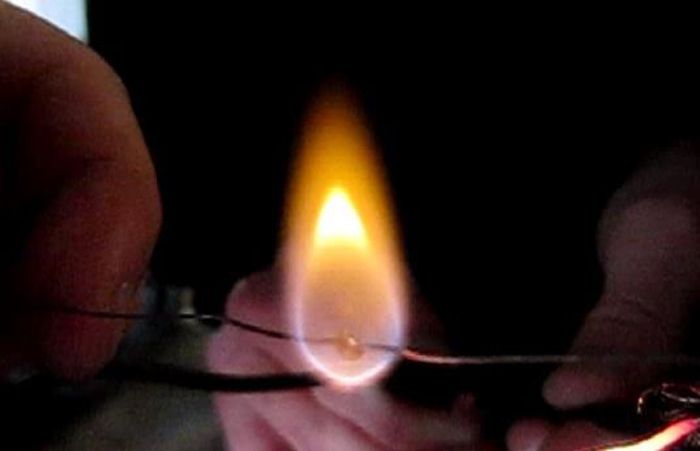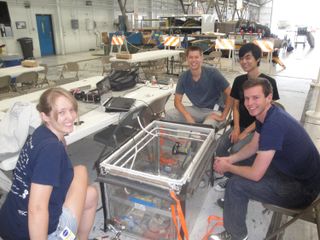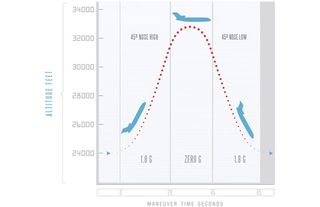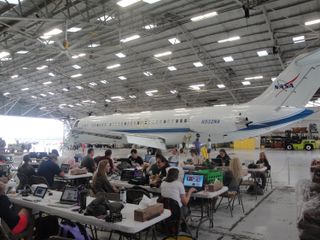Students to Spark Zero-Gravity Fires on Weightless Airplane Ride Today

HOUSTON — Gravity, get ready to meet your match. A team of students is counting down to light zero-gravity fires high in the sky today (July 18) aboard a jet plane designed specifically for weightless flights.
After months of preparation, eight engineering students from the University of California, San Diego are set to fly with NASA's Microgravity University today to test how biofuels burn in weightless conditions.
"I think the team is really looking forward to actually flying," Sam Avery, team leader for the UCSD Microgravity Team, told SPACE.com here Wednesday (July 17). [Photos: Zero-Gravity Science at NASA's Microgravity University]
Avery and his UCSD Microgravity Team spent a tense day Tuesday awaiting final NASA approval for their weightless fire experiment, which will create tiny controlled fires inside clear plastic case that is sealed inside two larger cases as a safety precaution. The main challenge: making sure the bolt torques needed to secure the flame experiment to its mount inside the aircraft met NASA's scrutiny and finding a replacement battery for the two GoPro cameras that will record the flames they ignite. By late afternoon, they got their answer: Their mission, NASA said, is a 'go.'
Weightless flames for science
The UCSD Microgravity Team is one of 14 groups of college students and teachers flying weightless missions with NASA's Microgravity University this week. Today's flight will ride aboard G-Force One, a jet owned by the Zero Gravity Corporation that offers brief stints of weightlessness by flying up and down on a parabolic trajectory.

The flight will take off from Ellington Field near NASA's Johnson Space Center and head out over the Gulf of Mexico to perform include 32 acrobatic parabolas. Each downward plunge should provide about 30 seconds of weightlessness that will be countered by stints of "hypergravity" when the aircraft pulls 2Gs (twice the force of Earth's gravity) on each upswing, NASA officials said. NASA's Microgravity Program is making four flights this week between July 12 and 20 to give all 14 teams a chance to perform their experiments.
Sign up for the Live Science daily newsletter now
Get the world’s most fascinating discoveries delivered straight to your inbox.
"They'll be testing everything from the way oil and water behave in microgravity to the way light reacts in microgravity," explained Frank Prochaska, NASA's reduced gravity flight program manager for student campaigns, in a July 12 interview.
The UCSD Microgravity Team is testing how biofuels burn in weightlessness by using a syringe to squeeze the fuel onto two crosshair-like wires, then igniting the mixture via a remote control box outside the fire chamber. Inlet and outlet ports mounted into the boxes sides should vent any excess smoke, Avery said.
The team will write a report on the experiment's results and hope to glean insights on how to better protect astronauts and spacecraft from in-space fire events.
In addition to Avery, the UCSD Microgravity Team includes aerospace engineering students Andrew Beeler, Jack Goodwin, Victor Hong, Daneesha Kenyon, Josh Sullivan, Joshua Siu, Joshua Sullivan, and mechanical engineering student Nico Montoya, with their NASA mentor Christina Gallegos rounding out the crew. Beeler, Montoya and Siu serve as the team's ground crew, while the rest are scheduled to fly in shifts during two of the research flights. This reporter is assigned as UCSD's official team journalist for today's flight, which is the first of the two trips.

Hoping for good weather
Stormy weather over Houston and the flight range used for NASA microgravity flights has caused some delays for the weightless missions this week. The UCSD team initially planned to make its first flight early this morning, but the weather delays have pushed their mission to the afternoon. Team members are
Montoya said he was surprised to learn that bad weather could pose a serious threat to the team's chances of flying. "That's a big worry right now," he told SPACE.com.

While most UCSD Microgravity Team members — including this reporter — will take advantage of anti-motion sickness medications offered by NASA, Avery and teammate Jack Goodwin plan to forgo the meds and literally trust their gut. [6 Everyday Things That Turn Weird in Space]
Avery said he's always had a strong stomach. To practice for the flight, the entire team took a trip to Pleasure Pier in nearby Galveston for a rollercoaster ride. Avery ate an entire funnel cake and then rode a rollercoaster to see if he might get sick. He didn't.
Goodwin also trusts his stomach and said he grew up near the ocean and spent a lot of time on boats. He also wanted to make sure he avoided any drowsiness that might crop up from the anti-motion sickness medications, he said.
Science and fun in weightlessness
While the UCSD Microgravity Team is dedicated to collecting good data from today's weightless flight, the students are also hoping to take advantage of their rare chance for a zero-gravity flight. They created a large team banner to display behind their experiment and hope to create their own zero-gravity music video set to the tune "The Scientist" by the band Flux Pavilion.
"The first line is 'I still wanna be a spaceman,'" Avery said. "And we thought that made sense."
While the UCSD team is studying biofuel flames in microgravity, some teams are analyzing how liquids flow in weightlessness, as well as how mock Mars dirt can burn. Here's a look at the full list of student and teacher teams flying with NASA's Microgravity University program this week:
The following is a list from NASA of the undergraduate teams set to ride the Vomit Comet this week with the names of their experiments:
- Baldwin Wallace University / John Carroll University: The Stability of Liquid Bridges under Varying Total Body Force
- Purdue University: Water Removal in Proton Exchange Membrane Fuel Cells
- Rice University Electromagnetic Position Sensing in Microgravity
- SUNY Buffalo: Microgravity Characterization of Zirconia Monolithic Electrokinetic Micropumps
- University of California San Diego: Fiber Supported Droplet Combustion of Bioethanol and Biobutanol
- University of Texas, El Paso: Combustion of Lunar and Martian Regolith Simulants with Magnesium
- West Virginia University: Optimization of Liquid Spray Cooling in a Variable Gravity Environment
And here are the teacher teams and their experiments:
- Team Kennedy, Hillsboro, MO: Absorbency of Liquids in Space
- Prior Lake-Savage Middle Schools, Prior Lake, MN: Behavior of Acoustic Energy in MicroGravity
- St. Joan of Arc School, Lisle, IL: Gravity's Affect on Magnets
- Evansville Day School, Evansville, IN: Tornado Fluid Flow in Microgravity
- Poinciana Elementary and Atlantic High School, Boynton Beach, FL: How Does Gravity Affect Convection?
- Einstein Fellows, Arlington, VA: Gravity's Impact on Coacervate Formation
- Riversink Elementary School, Crawfordville, FL: Wakulla Waters: A Liquid Investigation.
NASA's Microgravity University is one of several agency programs designed to enable access to weightless flights for students and researchers. The agency's Reduced Gravity Education Flight Program oversees the Microgravity University, as well as the Teaching from Space, Systems Engineering Education Discovery (SEED), and other related programs.
Editor's note:You can follow the progress of today's NASA Microgravity University Program flight via the program's Twitter feed @NASA_RGEFP and the hashtag #DefyGravity. UCSD Microgravity Team member Nico Montoya has been posting updates about the team's work at @NicoSuave9.
This story was provided by SPACE.com, a sister site to LiveScience. Email Tariq Malik at tmalik@space.com or follow him @tariqjmalik and Google+. Follow us @Spacedotcom, Facebook and Google+. SPACE.com News Editor Megan Gannon contributed to this report. Original article on SPACE.com.

Tariq is the editor-in-chief of Live Science's sister site Space.com. He joined the team in 2001 as a staff writer, and later editor, focusing on human spaceflight, exploration and space science. Before joining Space.com, Tariq was a staff reporter for The Los Angeles Times, covering education and city beats in La Habra, Fullerton and Huntington Beach. He is also an Eagle Scout (yes, he has the Space Exploration merit badge) and went to Space Camp four times. He has journalism degrees from the University of Southern California and New York University.










